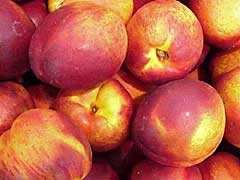


Home
Flowers &
Indoor Plants
Fruits & Nuts
Ornamentals
Vegetables
Special Topics
Resources
Glossary

|
Nectarine Prunus persica var. nectarina or nucipersica (proo-nus pur-sick-ah) 

Click on thumbnails for larger image. |
 |
What about it? The nectarine is a deciduous tree that grows to a height of 15-20 feet. The pink flowers bloom in the spring and can be quite showy. Some gardeners espalier nectarines. Unfortunately, this much-loved fruit is just slightly out of the winter hardiness range for most of New York state, with the exception of the mildest areas such as Long Island. What is it used for? Nectarines are most commonly enjoyed fresh. Some are canned and used m baking. Jams and marmalades can be made from nectarines, as well as fruit leather. Where does it grow? How do we grow it? Nectarines prefer light, well-drained soils, as long as adequate moisture can be maintained. Gardeners must avoid heavy clay and poorly-drained soils. Full sun is a necessity. Nectarines will require pruning, fertilizing, mulching and cleanup of fruit that has dropped to the ground. Nectarines are planted 18 feet apart. What are its primary problems? X-disease and silver leaf are responsible for the short life of many trees. Blast in spring and brown rot at maturity are difficult to control, especially in wet climates. Other common pests and diseases are leaf curl, scab, powdery mildew, mites, and the oriental fruit moth. How do we harvest and store it? Nectarines are hand picked very gently to avoid bruising. They will not handle or store well.
© Copyright, Department of Horticulture, Cornell University. |